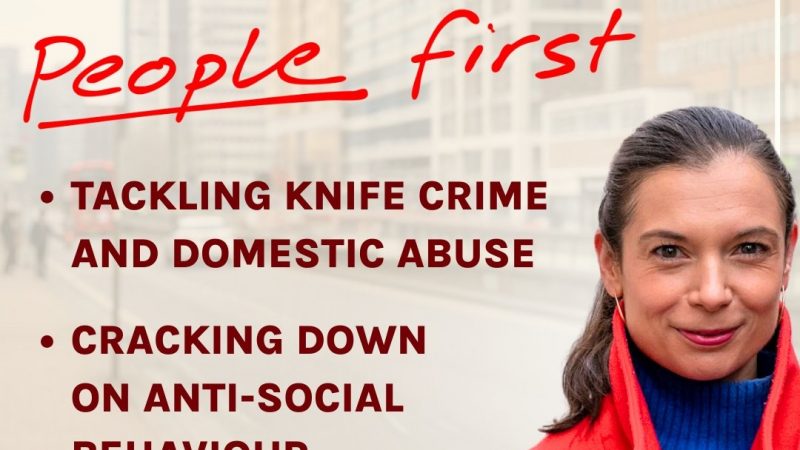
Rowenna Davis is one of two names on the shortlist to be Labour’s candidate for mayor of Croydon, the other being Davis’ fellow councillor Manju Shahul-Hameed.
The town has only had a directly elected mayor since 2022; the incumbent is the Conservative Jason Perry, who will be up again next May. Labour members are choosing who they want to stand, with voting closing on Monday, April 14th – that is, likely a few hours after you are reading this. A councillor for Waddon ward, Davis has been described by Inside Croydon as the contest’s “front-runner”.
This is a sentiment one Croydon Labour member I speak to echoes – even if they are, on the whole, not overwhelmingly optimistic about the chances of the eventual Labour candidate triumphing over the Tories, given continued unhappiness about Labour’s handling of council finances (the borough effectively declaring bankruptcy in 2020).
The 2015 MP that wasn’t is a real type
But let’s not discount our chickens before they’ve hatched: Labour will fight to win in Croydon, and who the candidate is will, obviously, be key to the outcome. Despite only having been a Croydon councillor since 2022 (her competitor, Shahul-Hameed, was first elected in 2006), Davis has a richer history in the party than most candidates, and one which sheds interesting light on the path of certain tendencies up to the present day.
Davis started her career as a journalist (even guest editing LabourList in 2009, condemning the publication as “laddish” as she did so), and spent a period as a councillor in Southwark in the early 2010s. She was an unsuccessful parliamentary candidate in a marginal seat in 2015, losing Southampton Itchen by 2316 votes.
READ MORE: Blue Labour ads, Blue Labour ideas
As I’ve written elsewhere, the 2015 MP-that-wasn’t is a real type, a lost sub-generation of big names under Miliband. Davis is very much in this grouping; following her loss to the Conservative Royston Smith, she became a teacher (her commendably detailed Wikipedia page labels this her “political interregnum”).
However, she is probably known best not for her failed parliamentary candidacy but instead for her 2011 book, Tangled Up In Blue, and her involvement with the first iteration of the Blue Labour tendency.
Blue Labour has been having a comeback
Blue Labour has been having a bit of a comeback in recent months, bolstered by the formation of a parliamentary group and a series of well-covered interventions from its guru Lord Glasman. Drawing heavily on the e-book The Labour Traditions, which emerged from a series of seminars about Blue Labour, Tangled Up In Blue came out in 2011 and was the first hard-copy book about the tendency.
Its subtitle is “Blue Labour and the struggle for Labour’s soul”; it remains a revealing text.
Tangled Up In Blue documents the ideas – a politics that is more relational, that wants to talk about the dignity of work, and that rejects the “elitist, technocratic and managerial” elements of new Labour – that informed Blue Labour. It closely follows Glasman’s development of these ideas and networks, starting with his work with the community organising group Citizens UK and going through to his elevation to the House of Lords by then-newly minted Labour leader Ed Miliband.
It is – as all books addressing very contemporary political trends are doomed to be – very dated, a snapshot of a pre-austerity world where David Cameron’s flirtations with “red Toryism” are taken in earnest, where who did or didn’t move against Gordon Brown is a live fault-line, and Barack Obama has wowed progressives the world over with his community organising informed presidential campaign.
While not afraid of depicting the ways in which it courted controversy, or missteps by Glasman, Davis’ book clearly very much buys what Blue Labour is selling. This supportive perspective is one of the things that contributes to making Tangled Up In Blue an odd book, above and beyond its somewhat dated nature.
I don’t regard Blue Labourists as ontologically interesting
I am someone intensely interested in Labour minutiae (really: I have written an oral history of a 2013 IPPR conference) but my feeling as I read it for this piece was mostly that there was not enough there. Its subject does not provide enough material to support a whole book, much as the author might have believed that it did.
Blue Labour generated a lot of attention (“there may have been a slight love of the drama” behind some of Glasman’s actions, the book notes), and, as Davis correctly observes, journalists loved covering it because it “pitted members of the same party against each other” (plus ca change).
Much covered, however, is not the same as influential, and the book doesn’t convincingly make the case that a bunch of men (and it really was men – Davis was one of very few women on the scene) having coffee in Portcullis House decisively changed the Labour Party. If the book has a denouement, it’s a series of seminars about (among other things) “Labour as a radical tradition”. The book does not make it clear what this cashed out to, instead viewing the tendency – and, particularly, Glasman – as ontologically interesting.
Personally, I don’t regard the Blue Labourists as ontologically interesting, but for all the book doesn’t convincingly argue that they won the struggle for Labour’s soul, neither do I think they have been uninfluential. At one point in the book, Davis quotes Glasman as saying that he “would really like to see Blue Labour having really dissolved into the Labour mainstream”. He was speaking in 2011; I think, by 2025, he has got his wish.
Starmer’s Labour, guided so heavily by Labour Together (which can be seen as an inheritor or evolution of Blue Labour, sharing both ideological DNA and involving various of the same actors, such as academic Jonathan Rutherford and former Dagenham MP Jon Cruddas), has put flags on membership cards, talked tough on immigration, and talked about the importance of work. This was but one of many unknowable things in 2011 (a Miliband defeat, a Corbyn leadership, a pandemic), but to my view this is the conclusion Davis’ book lacks: this influence on Starmerism is what Blue Labour cashed out to.
Perhaps Davis is the more revealing Blue Labour figure
Davis’s bid to be mayor of Croydon vindicates this continuity. Flicking through her website, looking at endorsements from local members and national figures (she “has what it takes to sort things out”, says Andy Burnham), there is nothing that would indicate that she is anything other than a completely typical Starmer-era candidate. Inside Croydon reports that she has not rebelled against the Labour whip since becoming a Croydon councillor; she talks about the importance of tackling fly-tipping.
If you’re straining, you can perhaps see communitarian impulses behind her assertion that the gutting of the town centre is “leaving a hole where our heart should be” and talk of putting people first – but there’s nothing there that you wouldn’t expect a Labour candidate with a completely different political history to say.
That, of course, does not mean that Davis’s political history has been recanted or is not relevant (the former journalist doesn’t do a huge amount of media post-interregnum, but did present the Labour case at a hustings put on by the post-liberal UnHerd website last year, suggesting a continued interest and involvement with the more conservative elements of Blue Labour’s networks).
If Glasman has got his 2011 wish to have his movement dissolve into the mainstream, he doesn’t seem to have noticed. Some positive words about the Scunthorpe steel nationalisation aside, most of his recent comments – calling the attorney general a fool, a bizarre appearance on Steve Bannon’s podcast, the pronouncement that the debates that matter are happening on the “left side of MAGA square” – tend to suggest he is unhappy with the state of the party.
Glasman is a great talker – the book notes his “verve and wit” – but, I think, too controversialist to ever quietly own a diffuse but real impact. Perhaps, then, Davis is the more revealing Blue Labour figure, if one wants to make assessments about how the tendency, a decade and a half on, has grown up and slotted into the party we have now.




More from LabourList
LabourList Christmas quiz 2025 round 4: Christmas Connects
EXCLUSIVE: A Christmas message from Hollie Ridley
‘Carol of the Bells: Christmas, Ukraine’s resistance and the fight for freedom’